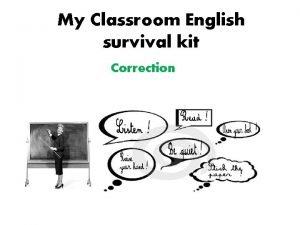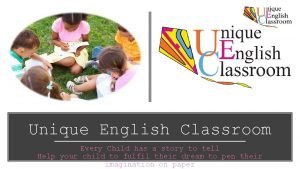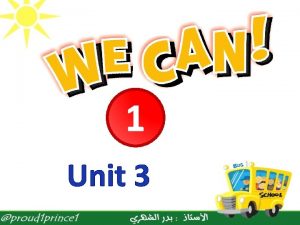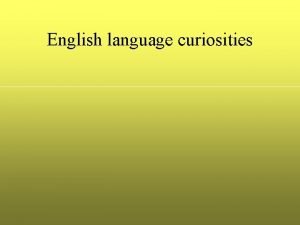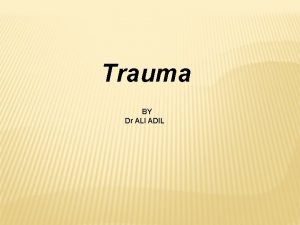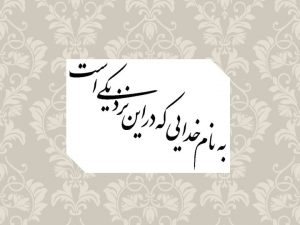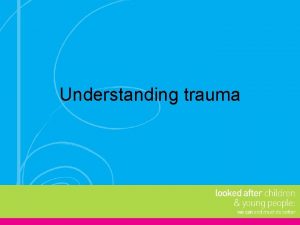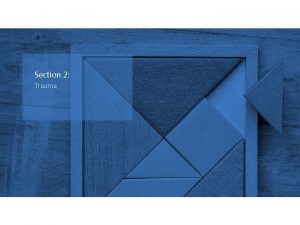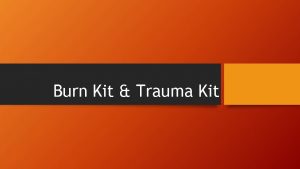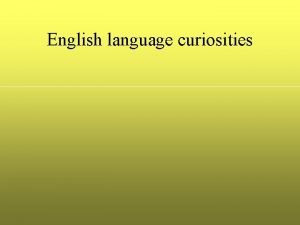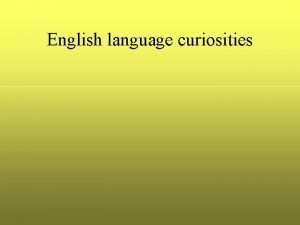The Curiosities of Trauma in the English Classroom
















- Slides: 16

The Curiosities of Trauma in the English Classroom The relationship between trauma, cognitive load and subject English ETAWA State Conference - 2019

Two Key Points 1. Brain can only process a limited amount of new information 2. No known limits to the amount of stored information the brain can process Source: Cognitive load theory: Research that teachers really need to understand Centre for Education Statistics and Evaluation Cognitive Load Image adapted from Kirschner, Sweller and Clark, 2006

Transfer to long-term memory A minimum of 24 repetitions is needed to take information to long term permanent memory (Allard, 2007)

Trauma Affects Thinking Disorganised minds Forgetfulness Limited attention span Shutdown Source: Calmer classrooms: A guide to working with traumatised children Department of Communities, Child Safety and Disability Services Department of Education, Training and Employment PLD

Warnbro Community High School > 60 % of student population with Developmental Trauma Background (DTB)

Transfer to long-term memory A minimum of 24 repetitions is needed to take information to long term permanent memory (Allard, 2007) It can take up to 70!

Predictable Practice “Children with a Developmental Trauma Background (DTB) experience change to routines and their environment as potential threat. The familiar is safer for these children than the unfamiliar. ” Source: The Australian Childhood Foundation’s Smart P. R. A. C. T. I. C. E. (2006) and adapted by the WCHS ESC

The WCHS English Lesson Framework

Now, about that content…

Year 7 English Language Literature LANGUAGE VARIATION AND CHANGE Understand the way LITERATURE AND CONTEXT Identify and explore ideas and language evolves to reflect a changing world, particularly in response to viewpoints about events, issues and characters represented in texts the use of new technology for presenting texts and drawn from different historical, social and cultural communicating (ACELA 1528) contexts (ACELT 1619) LANGUAGE FOR INTERACTION Understand how accents, styles of Reflect on ideas and opinions about characters, settings and events in speech and idioms express and create personal and social literary texts, identifying areas of agreement and difference with others identities (ACELA 1529) and justifying a point of view(ACELT 1620) Understand how language is used to evaluate texts and how evaluations about a text can be substantiated by reference to the text and other sources (ACELA 1782) Compare the ways that language and images are used to create character, and to influence emotions and opinions in different types of texts(ACELT 1621) TEXT STRUCTURE AND ORGANISATION Understand explain Discuss aspects of texts, for example their aesthetic and social value, how the text structures and language features of texts become more using relevant and appropriate metalanguage(ACELT 1803) complex in informative and persuasive texts and identify underlying structures such as taxonomies, cause and effect, and extended metaphors (ACELA 1531) Understand that the coherence of more complex texts relies on devices EXAMINING LITERATURE Recognise and analyse the ways that signal text structure and guide readers, for example overviews, characterisation, events and settings are combined in narratives, and initial and concluding paragraphs and topic sentences, indexes or site discuss the purposes and appeal of different approaches (ACELT 1622) maps or breadcrumb trails for online texts (ACELA 1763) Understand the use of punctuation to support meaning in complex Understand, interpret and discuss how language is compressed to sentences with prepositional phrases and embedded produce a dramatic effect in film or drama, and to create layers of clauses (ACELA 1532) meaning in poetry, for example haiku, tankas, couplets, free verse and verse novels (ACELT 1623) EXPRESSING AND DEVELOPING IDEAS Recognise and understand CREATING LITERATURE Create literary texts that adapt stylistic that subordinate clauses embedded within noun groups/phrases are a features encountered in other texts, for example, narrative viewpoint, common feature of written sentence structures and increase the density structure of stanzas, contrast and juxtaposition (ACELT 1625) of information (ACELA 1534) Understand how modality is achieved through discriminating choices in Experiment with text structures and language features and their effects modal verbs, adjectives and nouns (ACELA 1536) in creating literary texts, for example, using rhythm, sound Analyse how point of view is generated in visual texts by means of effects, monologue, layout, navigation and colour (ACELT 1805) choices, for example gaze, angle and social distance (ACELA 1764) Investigate vocabulary typical of extended and more academic texts and the role of abstract nouns, classification, description and generalisation in building specialised knowledge through language (ACELA 1537) Understand how to use spelling rules and word origins, for example Greek and Latin roots, base words, suffixes, prefixes, spelling patterns and generalisations to learn new words and how to spell them (ACELA 1539) Literacy TEXTS IN CONTEXT Analyse and explain the effect of technological innovations on texts, particularly media texts(ACELY 1765) INTERACTING WITH OTHERS Identify and discuss main ideas, concepts and points of view in spoken texts to evaluate qualities, for example the strength of an argument or the lyrical power of a poetic rendition (ACELY 1719) Use interaction skills when discussing and presenting ideas and information, selecting body language, voice qualities and other elements, (for example music and sound) to add interest and meaning (ACELY 1804) Plan, rehearse and deliver presentations, selecting and sequencing appropriate content and multimodal elements to promote a point of view or enable a new way of seeing (ACELY 1720) INTERPRETING, ANALYSING, EVALUATING Analyse and explain the ways text structures and language features shape meaning and vary according to audience and purpose (ACELY 1721) Use prior knowledge and text processing strategies to interpret a range of types of texts(ACELY 1722) Use comprehension strategies to interpret, analyse and synthesise ideas and information, critiquing ideas and issues from a variety of textual sources (ACELY 1723) Compare the text structures and language features of multimodal texts, explaining how they combine to influence audiences (ACELY 1724) CREATING TEXTS Plan, draft and publish imaginative, informative and persuasive texts, selecting aspects of subject matter and particular language, visual, and audio features to convey information and ideas (ACELY 1725) Edit for meaning by removing repetition, refining ideas, reordering sentences and adding or substituting words for impact (ACELY 1726) Consolidate a personal handwriting style that is legible, fluent and automatic and supports writing for extended periods (ACELY 1727) Use a range of software, including word processing programs, to confidently create, edit and publish written and multimodal

Year 7 English Language Literature LANGUAGE VARIATION AND CHANGE Understand the way LITERATURE AND CONTEXT Identify and explore ideas and language evolves to reflect a changing world, particularly in response to viewpoints about events, issues and characters represented in texts the use of new technology for presenting texts and drawn from different historical, social and cultural communicating (ACELA 1528) contexts (ACELT 1619) LANGUAGE FOR INTERACTION Understand how accents, styles of Reflect on ideas and opinions about characters, settings and events in speech and idioms express and create personal and social literary texts, identifying areas of agreement and difference with others identities (ACELA 1529) and justifying a point of view(ACELT 1620) Understand how language is used to evaluate texts and how evaluations about a text can be substantiated by reference to the text and other sources (ACELA 1782) Compare the ways that language and images are used to create character, and to influence emotions and opinions in different types of texts(ACELT 1621) TEXT STRUCTURE AND ORGANISATION Understand explain Discuss aspects of texts, for example their aesthetic and social value, how the text structures and language features of texts become more using relevant and appropriate metalanguage(ACELT 1803) complex in informative and persuasive texts and identify underlying structures such as taxonomies, cause and effect, and extended metaphors (ACELA 1531) Understand that the coherence of more complex texts relies on devices EXAMINING LITERATURE Recognise and analyse the ways that signal text structure and guide readers, for example overviews, characterisation, events and settings are combined in narratives, and initial and concluding paragraphs and topic sentences, indexes or site discuss the purposes and appeal of different approaches (ACELT 1622) maps or breadcrumb trails for online texts (ACELA 1763) Understand the use of punctuation to support meaning in complex Understand, interpret and discuss how language is compressed to sentences with prepositional phrases and embedded produce a dramatic effect in film or drama, and to create layers of clauses (ACELA 1532) meaning in poetry, for example haiku, tankas, couplets, free verse and verse novels (ACELT 1623) EXPRESSING AND DEVELOPING IDEAS Recognise and understand CREATING LITERATURE Create literary texts that adapt stylistic that subordinate clauses embedded within noun groups/phrases are a features encountered in other texts, for example, narrative viewpoint, common feature of written sentence structures and increase the density structure of stanzas, contrast and juxtaposition (ACELT 1625) of information (ACELA 1534) Understand how modality is achieved through discriminating choices in Experiment with text structures and language features and their effects modal verbs, adjectives and nouns (ACELA 1536) in creating literary texts, for example, using rhythm, sound Analyse how point of view is generated in visual texts by means of effects, monologue, layout, navigation and colour (ACELT 1805) choices, for example gaze, angle and social distance (ACELA 1764) Investigate vocabulary typical of extended and more academic texts and the role of abstract nouns, classification, description and generalisation in building specialised knowledge through language (ACELA 1537) Understand how to use spelling rules and word origins, for example Greek and Latin roots, base words, suffixes, prefixes, spelling patterns and generalisations to learn new words and how to spell them (ACELA 1539) Literacy TEXTS IN CONTEXT Analyse and explain the effect of technological innovations on texts, particularly media texts(ACELY 1765) INTERACTING WITH OTHERS Identify and discuss main ideas, concepts and points of view in spoken texts to evaluate qualities, for example the strength of an argument or the lyrical power of a poetic rendition (ACELY 1719) Use interaction skills when discussing and presenting ideas and information, selecting body language, voice qualities and other elements, (for example music and sound) to add interest and meaning (ACELY 1804) Plan, rehearse and deliver presentations, selecting and sequencing appropriate content and multimodal elements to promote a point of view or enable a new way of seeing (ACELY 1720) INTERPRETING, ANALYSING, EVALUATING Analyse and explain the ways text structures and language features shape meaning and vary according to audience and purpose (ACELY 1721) Use prior knowledge and text processing strategies to interpret a range of types of texts(ACELY 1722) Use comprehension strategies to interpret, analyse and synthesise ideas and information, critiquing ideas and issues from a variety of textual sources (ACELY 1723) Compare the text structures and language features of multimodal texts, explaining how they combine to influence audiences (ACELY 1724) CREATING TEXTS Plan, draft and publish imaginative, informative and persuasive texts, selecting aspects of subject matter and particular language, visual, and audio features to convey information and ideas (ACELY 1725) Edit for meaning by removing repetition, refining ideas, reordering sentences and adding or substituting words for impact (ACELY 1726) Consolidate a personal handwriting style that is legible, fluent and automatic and supports writing for extended periods (ACELY 1727) Use a range of software, including word processing programs, to confidently create, edit and publish written and multimodal

How to Create Great Guiding Questions (p. 39) q. Address the standards. q. Identify the knowledge students need to learn. Jim Knight – High Impact Instruction q. Identify the skills students need to learn. q. Identify the big ideas students need to learn. q. Choose meaningful or important topics. q. Choose personally relevant topics. q. Use the most appropriate words. q. Keep language easy to understand.

Unit Planning Framework Unit Title Mentor Texts Exploring Marvel’s Heroes through Non Fiction Texts Movie posters Film reviews Information texts about Marvel characters using the five information text structures Unit Length 5 Weeks Assessments Multi-choice test on information text structures Annotated film review Primary Content Descriptor Understand explain how the text structures and language features of texts become more complex in informative and persuasive texts and identify underlying structures such as taxonomies, cause and effect, and extended metaphors (ACELA 1531) Secondary Content Descriptors Understand that the coherence of more complex texts relies on devices that signal text structure and guide readers, for example overviews, initial and concluding paragraphs and topic sentences, indexes or site maps or breadcrumb trails for online texts (ACELA 1763) Understand how modality is achieved through discriminating choices in modal verbs, adjectives and nouns (ACELA 1536) Ongoing Content Descriptors ACELA 1532, ACELT 1803, ACELY 1721, ACELY 1722, ACELY 1725, ACEL 1726 Knowledge (nouns) Skills (verbs) Big Ideas Text structures Language features Informative texts Persuasive texts Taxonomies Cause and effect Extended metaphor Terminology Words Non-fiction texts Information texts Description Cause and Effect Compare and Contrast Sequence Problem Solution Persuasive texts Repetition Hyperbole Rhetorical question Understand Explain Identify Informative and persuasive texts have specific structures and language features that increase their complexity. Students need to be able to identify, understand explain those structures. Vocabulary Words Abandoned Beware Confidence Damage Exciting Frightened Galaxy Hilarious Intention Muscular Opposition Personalities Grammar Focus Clauses Commas

Week 1 Session 2 Session 3 Session 4 Review Non-fiction and informative texts Vocabulary Clauses Description Sequence Vocabulary Compound Sentences Description Sequence Cause and Effect Vocabulary – review all words Clauses, compound sentences and coordinating conjunctions Literacy Terminology Non-fiction texts Informative texts Vocabulary Abandoned Grammar Clauses Terminology Sequence Description Vocabulary Exciting Grammar Compound sentences Terminology Cause and Effect Vocabulary Intention Grammar Coordinating conjunctions Terminology Compare and Contrast Vocabulary Personalities Grammar Comma Content Informative texts overview Informative texts – description and Informative texts – cause and sequence effect Informative Texts – compare and contrast Writing Write a sequence of 5 -10 events since you woke up this morning. Select a marvel hero. Use the graphic organiser to collate information for a description. Write a description. Use a Venn diagram to compare and contrast two marvel characters’ personalities, then write a paragraph that summarises your thoughts Reflect on an event from a Marvel film. Use a T-chart to list the causes and effects then write a paragraph summarising the causes and effects

Important Not just for students with DTB Supports the cognitive load of all students

Calmer classrooms: A guide to working with traumatised children Department of Communities, Child Safety and Disability Services Department of Education, Training and Employment PLD References / Sources Kirchner PA; Sweller J & Clark R (2006) Why Minimal Guidance During Instruction Does Not Work: An Analysis of the Failure of Constructivist, Discovery, Problem-Based, Experiential, and Inquiry. Based Teaching, Educational Psychologist Knight, J High Impact Instruction SCSA for Curriculum Documents The Australian Childhood Foundation’s Smart P. R. A. C. T. I. C. E. (2006) and adapted by the WCHS ESC
 Bear animal kingdom
Bear animal kingdom Cse smart class
Cse smart class English survival kit pdf
English survival kit pdf Unique english classroom
Unique english classroom Classroom english flashcards
Classroom english flashcards Hát kết hợp bộ gõ cơ thể
Hát kết hợp bộ gõ cơ thể Lp html
Lp html Bổ thể
Bổ thể Tỉ lệ cơ thể trẻ em
Tỉ lệ cơ thể trẻ em Chó sói
Chó sói Tư thế worm breton là gì
Tư thế worm breton là gì Alleluia hat len nguoi oi
Alleluia hat len nguoi oi Các môn thể thao bắt đầu bằng tiếng đua
Các môn thể thao bắt đầu bằng tiếng đua Thế nào là hệ số cao nhất
Thế nào là hệ số cao nhất Các châu lục và đại dương trên thế giới
Các châu lục và đại dương trên thế giới Công thức tính độ biến thiên đông lượng
Công thức tính độ biến thiên đông lượng Trời xanh đây là của chúng ta thể thơ
Trời xanh đây là của chúng ta thể thơ


